






 |
||||
 |
 |
 |
 |
 |
 |
||||
|
F E B R U A R Y 2 0 0 9 Alumni News | ||||||
|
For more alumni info visit alumni.jhu.edu
Follow this link to
Send email to |
James M. McPherson, A&S '63 (PhD): Inventing the "Modern" Wartime Presidency
Abraham Lincoln stands tall among American presidents, and so
does the pile of books written about him. This month, as the
nation celebrates the 200th birthday of the president who won
the Civil War and ended slavery in the United States, it also
contemplates the historic importance of its first
African-American president. It seems that Lincoln is as
timely as ever. |
|||||
 Civil War historian James McPherson's new book explores
the military side of the 16th president.
Civil War historian James McPherson's new book explores
the military side of the 16th president. |
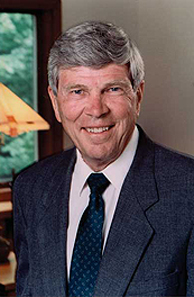 James M. McPherson has contributed to that pile. One of the
country's preeminent Civil War historians and a professor of
history at Princeton for 42 years, McPherson has authored 18
books about Lincoln or the war, many of which examine their
topics through the lens of race. By far his most renowned
work, though, is the Pulitzer Prize-winner Battle Cry of
Freedom (Oxford University Press, 1988), a survey of the
war that managed to impress academics with its hefty
scholarship while at the same time delighting general
audiences with its compelling narration — no easy
task.
James M. McPherson has contributed to that pile. One of the
country's preeminent Civil War historians and a professor of
history at Princeton for 42 years, McPherson has authored 18
books about Lincoln or the war, many of which examine their
topics through the lens of race. By far his most renowned
work, though, is the Pulitzer Prize-winner Battle Cry of
Freedom (Oxford University Press, 1988), a survey of the
war that managed to impress academics with its hefty
scholarship while at the same time delighting general
audiences with its compelling narration — no easy
task.His most recent book, Tried by War: Abraham Lincoln as Commander in Chief (Penguin Press, 2008), focuses on Lincoln's skills as commander-in-chief. McPherson's argument in Tried by War centers around the fact that the U.S. Constitution nowhere defines the president's powers as commander-in-chief. Nor did presidential action in previous wars offer Lincoln any consistent guidance in waging the war of his day. So Lincoln developed what can be considered a modern sense of how a president leads a nation during war. "One thing that impressed me was just how quickly, how thoroughly, he grasped the essentials of military strategy and was quite advanced," McPherson says. Lincoln's military commanders, for instance, "failed to take into consideration that political considerations were crucial," he says. "It could not just be a war fought by arms in a vacuum. He was modern in that respect." Whether dealing with such hapless commanders as the perpetually cautious and bumbling George B. McClellan early in the war or the much more astute and aggressive Ulysses S. Grant late in the war, Lincoln often found himself making the major strategic decisions that in effect made him general-in-chief as well as commander-in-chief. Lincoln complained that the Union Army, which outnumbered the Confederate Army, was slow moving and risk averse. McClellan in particular, McPherson writes, always seemed to be preparing for battles and then procrastinating rather than going on the offensive. Grant finally exercised the kind of initiative that Lincoln advocated. Lincoln sent numerous telegrams to his generals in the field, often chiding them for not pursuing the war more vigorously. Considering how much of Lincoln's tenure was consumed with conducting the war — and considering the fact that the United States is now fighting wars on several fronts — the topic of his military acumen has gotten surprisingly little attention of late. Scholars half a century ago took it up, McPherson explains, but contemporary historians have tended to be more interested in social, rather than military, history. McPherson thought it deserved more scholarly attention.
McPherson, a native Minnesotan, came to Johns Hopkins as a
graduate student in the late 1950s because he wanted to study
under the renowned Civil War historian C. Vann Woodward. "The
substance of his lectures was wonderful," he says, "and he
was a role model in terms of scholarship, writing, and the
ability to make the past relevant to an understanding of the
present." |
|||||
 "Few historians write as well as McPherson, and none evoke
the sound of battle with greater clarity. There is scarcely
anyone writing today who mines original sources more
diligently."
"Few historians write as well as McPherson, and none evoke
the sound of battle with greater clarity. There is scarcely
anyone writing today who mines original sources more
diligently."—The New York Times |
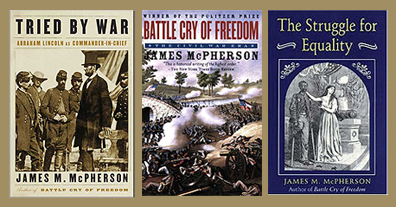 In the early 1960s, Baltimore was still a segregated city, and when Hopkins and Morgan State students, led by the late Hopkins chaplain Chester Wickwire, protested at a movie theater in northeast Baltimore, McPherson was part of the picket line. Experiences like these colored his study of the events of the Civil War. "It certainly was in my consciousness to make connections between then [the Civil War era] and now [the civil rights era] as I wrote my dissertation," he says. "I didn't know if I was living in the 1860s or the 1960s." That dissertation became his first book, The Struggle for Equality, published in 1964 after he had taken the position on the Princeton faculty.
That was the beginning of a career of writing and teaching,
but also of gaining an ever-more intimate understanding of
the Civil War and the people who fought it. He has built a
considerable reputation on his ability to bring history alive
in a serious, but eminently readable way. In its review of
McPherson's Tried By War, The New York Times wrote:
"Few historians write as well as McPherson, and none evoke
the sound of battle with greater clarity. There is scarcely
anyone writing today who mines original sources more
diligently."
Andrew Chen, A&S '93, Engr '94 (MS), Med '97: When Skiers Really Hit the Slopes
When elite American ski jumpers crash-land after hurtling
through the air at speeds approaching 95 miles per hour,
Andrew Chen is often the doctor responsible for treating
their head and shoulder injuries, bruised knees, and sprained
ankles. Chen, a nationally recognized orthopedic surgeon and
sports medicine specialist, is head physician of the U.S. Ski
Jump Team and a team physician for the U.S. Ski and Snowboard
Team. "These guys are flying," Chen says. "When they don't
land jumps properly, it can be more like a trauma case than
a simple ski accident." |
|||||
 Andrew Chen (left), physician to the ski, ski jump, and
snow board stars, is ready to treat a crash
landing.
Andrew Chen (left), physician to the ski, ski jump, and
snow board stars, is ready to treat a crash
landing. |
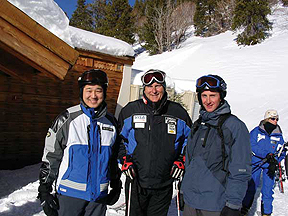 Chen earned his bachelor's in biology and his master's in
materials science and engineering at Johns Hopkins, then went
on to medical school at Johns Hopkins and a residency in
orthopedic surgery at the Hospital for Joint Diseases in New
York. But Chen, an amateur skier and snowboarder, found his
true medical calling on the slopes: He became interested in
managing the care of professional athletes, particularly
skiers, while completing a sports medicine fellowship at the
prestigious Steadman Hawkins Foundation in Vail, Colorado. He
has since helped care for the Denver Broncos, Colorado
Rockies, and the Alvin Ailey Dance Company in New York. These
days, Chen divides his time between the Alpine Clinic in New
Hampshire — where he treats mostly skiers of the
non-Olympic variety — and the ski and ski jump teams.
He first began working with the U.S. Ski and Snowboard Team
in 2006, when officials asked him to join the medical staff.
In 2008, he added the Ski Jump team after a chance encounter
at a bar in Finland with a World Cup executive. (Chen struck
up a conversation with the only person in the bar speaking
English; impressed by Chen's background, the World Cup honcho
urged him to apply for the top doc spot.)
Chen earned his bachelor's in biology and his master's in
materials science and engineering at Johns Hopkins, then went
on to medical school at Johns Hopkins and a residency in
orthopedic surgery at the Hospital for Joint Diseases in New
York. But Chen, an amateur skier and snowboarder, found his
true medical calling on the slopes: He became interested in
managing the care of professional athletes, particularly
skiers, while completing a sports medicine fellowship at the
prestigious Steadman Hawkins Foundation in Vail, Colorado. He
has since helped care for the Denver Broncos, Colorado
Rockies, and the Alvin Ailey Dance Company in New York. These
days, Chen divides his time between the Alpine Clinic in New
Hampshire — where he treats mostly skiers of the
non-Olympic variety — and the ski and ski jump teams.
He first began working with the U.S. Ski and Snowboard Team
in 2006, when officials asked him to join the medical staff.
In 2008, he added the Ski Jump team after a chance encounter
at a bar in Finland with a World Cup executive. (Chen struck
up a conversation with the only person in the bar speaking
English; impressed by Chen's background, the World Cup honcho
urged him to apply for the top doc spot.)
Chen, who specializes in knee and shoulder injuries, spends
about six weeks a year traveling with the ski jump team.
"It's a busy life," says Chen. "I'm trying to maintain a full
clinical practice, I try to keep a hand in research, and I am
currently writing a textbook." But it's a rewarding one, he
says. "Taking an athlete at the top level who's been
sidelined and getting them back to the pinnacle of
performance is very gratifying."
Mia Birk, SAIS '90: Pedal Power vs. Car Culture
The easiest fix to a wide variety of contemporary American
woes — volatile fuel costs, pollution, even obesity
— was invented nearly 150 years ago: the bicycle. Or so
says Mia Birk, an award-winning bicycle and pedestrian urban
planner. |
|||||
 Bicycle and pedestrian urban planner Mia Birk: "We want to
change perceptions so that it'll be something normal to just
get on a bike and go."
Bicycle and pedestrian urban planner Mia Birk: "We want to
change perceptions so that it'll be something normal to just
get on a bike and go." |
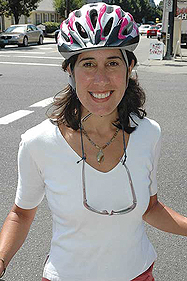 For the past 17 years, Birk has made a mission of getting
more of her fellow citizens out of their cars and onto their
bikes. Her work in the 1990s as Portland, Oregon's Bicycle
Program manager led to the quadrupling of miles of bikeway
paths and lanes in that city. Today, some 8 percent of trips
taken by Portland residents are done by bicycle, one of the
highest rates in the nation. That number is as high as 28
percent in some neighborhoods.
For the past 17 years, Birk has made a mission of getting
more of her fellow citizens out of their cars and onto their
bikes. Her work in the 1990s as Portland, Oregon's Bicycle
Program manager led to the quadrupling of miles of bikeway
paths and lanes in that city. Today, some 8 percent of trips
taken by Portland residents are done by bicycle, one of the
highest rates in the nation. That number is as high as 28
percent in some neighborhoods.Currently a principal at Alta Planning + Design — a Portland-based company that researches, plans, and creates bike, pedestrian, and greenway projects all over the world — and a professor at Portland State University, she's also at work on her first book, Joyride: A Woman's Journey to Empower People and Transform Communities. Just back from a fact-finding trip to bike-friendly Amsterdam and Copenhagen, Birk explains her eureka moment, her work, and how to alter America's car culture.
You're one of the nation's preeminent bicycling advocates,
yet you didn't even start riding a bike until graduate
school?
Your work in Portland garnered the city a lot of
attention. Why did things work there?
When gas prices spike up, as they did last summer, does
your phone start ringing?
Are some cities just impossible to make more bicycle
friendly?
How do you work with areas where biking isn't regarded as
viable transportation?
Are U.S. cities becoming more actively interested in
developing bike systems?
Elizabeth Gradie-Chinn, Bus '00, and Deborah Rivera-Wienhold, Bus '01: A Dream Come True
Unlike most bouts of insomnia, Deborah Rivera-Wienhold's
turned out to be rather productive. After a stretch of
sleepless nights, she was eventually lulled to sleep with the
help of a body pillow. That set Rivera-Wienhold, who has a
background in early childhood education, to thinking: Could
a creatively designed, child-sized body pillow do the same
for kids who have trouble sleeping? |
|||||
 The DreamKuddle Pillow
The DreamKuddle Pillow |
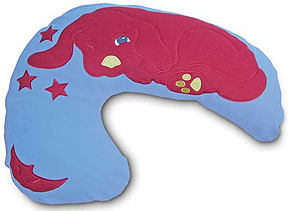 With friend and fellow Carey Business School alumna Elizabeth
Gradie-Chinn, she set out to see if the idea could work. They
conducted focus groups, mostly with moms, and reviewed
existing research on children and sleep. Gradie-Chinn, an
amateur seamstress, developed a prototype — a brightly
colored pillow with an animal appliqué. It had a
curved shape designed to promote proper spine alignment, a
soft fleece exterior, and by 2004, a name: the DreamKuddle
Pillow. The two spent another year conducting market
research, creating a business plan, and identifying a
manufacturer. "It was surprising how tough the juvenile
market is," says Gradie-Chinn. "It's a very competitive,
tough, business-a crowded, noisy market."
With friend and fellow Carey Business School alumna Elizabeth
Gradie-Chinn, she set out to see if the idea could work. They
conducted focus groups, mostly with moms, and reviewed
existing research on children and sleep. Gradie-Chinn, an
amateur seamstress, developed a prototype — a brightly
colored pillow with an animal appliqué. It had a
curved shape designed to promote proper spine alignment, a
soft fleece exterior, and by 2004, a name: the DreamKuddle
Pillow. The two spent another year conducting market
research, creating a business plan, and identifying a
manufacturer. "It was surprising how tough the juvenile
market is," says Gradie-Chinn. "It's a very competitive,
tough, business-a crowded, noisy market."Within a year, DreamKuddle Pillows were for sale in 100 specialty stores. Rivera-Wienhold and Gradie-Chinn patented the design, and in 2007, they signed a license agreement with Jay at Play, the children's division of Jay Franco and Sons. The deal gave the company control of the product, but gave the inventors a percentage of sales. Now, you can find the duo's work marketed as Mushabelly pillows.
The current incarnation looks very different from the
original. It's more like a stuffed animal — a bird, a
giraffe, a penguin — and it makes noise when you
squeeze its belly. There's also a Web site, where children
can register their pillows in Mushabelly University or take
them to a virtual show at Mushabelly Concert Arena. "We love
what Jay Franco did," says Rivera-Wienhold. "It was a great
learning experience. We really used our newly minted MBAs,
and it's exciting to know the idea has merit."
What do you get when you mix together hundreds of alumni volunteers, a mountain of crabs, and 20 years of history? One whirlwind October weekend! The traditional fall gathering of university trustees and alumni, Leadership Weekend 2008 offered an opportunity for alumni to reconnect with each other, the university, and the work of the Alumni Association through advisory council meetings, student leadership lunches, a crab feast, and the Alumni Council 20th Anniversary Celebration Dinner.
During the Knowledge for the World campaign, which concluded
December 31, Johns Hopkins established 92 new professorships,
a new deanship in the Whiting School, and a directorship and
a curatorship in the Sheridan Libraries. |
|||||
 Nick Jones, who holds the Benjamin T. Rome Deanship at the
Whiting School of Engineering, with Joe Reynolds, Eng '69
(seated), and his wife, Lynn, at the dedication of the Joseph
R. and Lynn C. Reynolds Professorship.
Nick Jones, who holds the Benjamin T. Rome Deanship at the
Whiting School of Engineering, with Joe Reynolds, Eng '69
(seated), and his wife, Lynn, at the dedication of the Joseph
R. and Lynn C. Reynolds Professorship. |
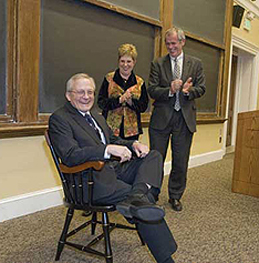 Endowed faculty positions date back five centuries to 1502,
when Margaret, countess of Richmond (and mother of Henry
VII), created the first endowed chairs in divinity at the
universities of Oxford and Cambridge. Today, Johns Hopkins
boasts more than 350 named professorships, with the
university's first endowed chair having been established in
1889.
Endowed faculty positions date back five centuries to 1502,
when Margaret, countess of Richmond (and mother of Henry
VII), created the first endowed chairs in divinity at the
universities of Oxford and Cambridge. Today, Johns Hopkins
boasts more than 350 named professorships, with the
university's first endowed chair having been established in
1889.
"Of all the fine gifts a university receives, none makes a
more profound or more permanent difference than the gift of
an endowed professorship," says university President William
R. Brody. "It serves our mission of teaching, research, and
service in an especially powerful and visible way. A
professorship has the permanence of endowment, and it allows
us to attract the best faculty minds we can identify anywhere
in the world."
Chris Beyrer, SPH '90, director of the Center for Public Health at the Bloomberg School of Public Health, co-authored an op-ed piece in the December 2 Boston Globe titled "An Unnatural Disaster in Burma." The piece describes the imprisonment of humanitarian aid workers and civilian volunteers and the struggle of the international community to protect public health following the devastation of Cyclone Nargis in May 2008. Timothy F. Geithner, SAIS '85, was appointed secretary of the treasury by President-elect Barack Obama in November. Geithner has served as president and CEO of the Federal Reserve Bank of New York since 2003. He has served under three presidents at the Department of Treasury, including as under secretary of the Treasury for international affairs from 1999 to 2001. Evan Ryan, SAIS '06, was appointed assistant to the vice president for intergovernmental affairs and public liaison by Vice President-elect Joe Biden, also in November. She served as an advisory to the Biden campaign, and on the White House staff as special assistant to the first lady's chief of staff and then as deptuy director of scheduling in the Clinton administration. Jonathan Groce, A&S '04, shared an Emmy win for Outstanding Game Show for the Discovery Channel's Cash Cab, in which unsuspecting passengers become contestants who are asked general knowledge questions en route to their destinations. If they answer correctly, they get cash; if not, they get ejected from the cab. Groce works as a casting and development producer with Lion Television, the show's production company.
Lee wrote: "The picture was taken on the grounds of the Royal Livingstone Hotel in Livingstone, Zambia. It's on the banks of the Zambezi River, right at the top of Victoria Falls. There were baboons all over the property, which made the experience that much more fun. We came across this mother and child right at the bank of the river." For a complete list of all Alumni Journeys photo submissions, and a look at the full list of 2009 destinations, visit alumni.jhu.edu/travel.
|
 |
|
 The Johns Hopkins Magazine |
901 S. Bond St. | Suite 540 |
Baltimore, MD 21231
The Johns Hopkins Magazine |
901 S. Bond St. | Suite 540 |
Baltimore, MD 21231Phone 443-287-9900 | Fax 443-287-9898 | E-mail jhmagazine@jhu.edu |
|